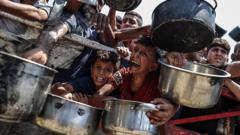Is Gaza Facing an Imminent Famine Crisis?

The Humanitarian Crisis in Gaza: A Deep Dive into the Current Famine Situation
The Gaza Strip is currently facing one of the most severe humanitarian crises in recent history, as reported by global food security experts from the Integrated Food Security Phase Classification (IPC). With famine thresholds being reached and the alarming rise in malnutrition and hunger-related deaths, the situation for the 2.1 million Palestinians living in this densely populated territory is dire. This article aims to explore the complex factors contributing to the growing famine crisis in Gaza, the implications for its residents, and the urgent need for international intervention.
The Current State of Food Security in Gaza
According to the IPC's latest alert, the Gaza Strip is experiencing widespread starvation and malnutrition. The data indicates that most regions, especially Gaza City, have reached alarming levels of acute malnutrition. As noted, "The facts are in - and they are undeniable," emphasizing the gravity of the situation. UN Secretary General António Guterres has characterized this crisis as a humanitarian catastrophe of epic proportions, calling for immediate action and a significant increase in aid deliveries.
Understanding Famine Classifications
Famine is classified based on specific criteria, with the IPC's Phase 5 (Catastrophe) designation representing extreme food scarcity and starvation. According to the IPC, for a famine to be officially declared in a specific area, several conditions must be met, including:
- Severe lack of food consumption among the population.
- High rates of acute malnutrition, particularly among children.
- Evident starvation-related deaths.
The Impact of Military Operations on Civilians
The Israeli military offensive has significantly exacerbated the humanitarian situation in Gaza. As military bombardments intensified over the past two months, access to food and other essential supplies has become alarmingly erratic. The IPC report highlights the "devastating impact" of these operations on civilians and critical infrastructure, making it increasingly difficult for aid organizations to deliver necessary assistance.
Rising Malnutrition Rates
Malnutrition rates have surged, particularly among children. The Gaza Nutrition Cluster has reported that more than 20,000 children have been admitted to clinics for acute malnutrition between April and mid-July, with over 3,000 classified as severely malnourished. Tragically, hospitals are witnessing a rapid increase in hunger-related deaths, particularly among children under five years of age. This alarming trend underscores the urgent need for immediate humanitarian intervention.
The Humanitarian Response: An Ocean of Aid Needed
UN agencies and humanitarian organizations have called for an "ocean" of aid to flow into Gaza. They emphasize that food, water, medicine, and fuel must be delivered without obstruction to alleviate the immense suffering faced by the population. The call for a ceasefire is critical, as ongoing hostilities hinder the delivery of essential supplies.
Challenges in Aid Delivery
Despite claims from Israeli officials that aid is reaching Gaza, the reality on the ground tells a different story. Reports indicate that the flow of aid remains inadequate, with the World Food Programme (WFP) and UNICEF highlighting that "barely a trickle" of what is needed has entered the territory. More than 62,000 tonnes of aid are required each month to cover basic humanitarian needs, yet many residents report not receiving any assistance.
The Role of International Organizations
International organizations like the WFP and UNICEF play a crucial role in addressing the humanitarian crisis in Gaza. They are on the front lines, providing essential food and nutritional assistance to those in need. However, as the WFP's executive director, Cindy McCain, noted, waiting for official confirmation of famine before providing aid is unconscionable. Immediate action is necessary to prevent further loss of life.
The Social Consequences of Famine
The social implications of the famine crisis in Gaza are profound. Families are struggling to secure basic necessities, and many are resorting to desperate measures to survive. Reports of looting and criminal activities surrounding aid distribution have emerged, with individuals paying exorbitant prices for essential items like flour. This social breakdown highlights the urgent need for a coordinated humanitarian response and long-term solutions to the crisis.
The Political Dimension of the Crisis
The ongoing conflict between Israel and Hamas significantly complicates the humanitarian landscape in Gaza. Israeli officials argue that Hamas bears responsibility for the tough reality facing the population. However, the humanitarian crisis cannot be solely attributed to one party. The complexities of the conflict, including the blockade and military operations, have created a perfect storm for disaster.
The Need for a Ceasefire
Experts agree that a ceasefire is essential for facilitating humanitarian aid delivery to Gaza. Without a halt to hostilities, the suffering endured by civilians is likely to worsen. The IPC has called for immediate action to alleviate suffering, emphasizing that restoring basic services and ensuring safe access to life-saving assistance is paramount.
Conclusion: A Call for Immediate Action
The humanitarian crisis in Gaza is unfolding before our eyes, with the potential for mass starvation looming. As the international community grapples with the complexities of the situation, it is crucial that immediate action is taken to provide the necessary support to those in need. The people of Gaza cannot wait any longer for aid; they need an ocean of assistance to survive this catastrophic crisis.
FAQs
What are the main causes of the current famine in Gaza?
The famine in Gaza is primarily caused by the ongoing conflict, military operations, and a blockade that restricts the flow of essential supplies such as food, water, and medical aid.
How many people are affected by the famine in Gaza?
Approximately 2.1 million Palestinians are currently living in Gaza, with a significant portion facing acute food insecurity and malnutrition.
What actions are being taken to address the crisis?
International organizations, including the UN, WFP, and UNICEF, are calling for immediate humanitarian aid to be delivered without obstruction. They are also advocating for a ceasefire to facilitate aid distribution.
As the world watches the unfolding tragedy in Gaza, the question remains: what more can be done to ensure that the people of Gaza receive the aid they desperately need? #GazaCrisis #HumanitarianAid #FamineResponse
Published: 2025-07-29 17:00:21 | Category: technology



